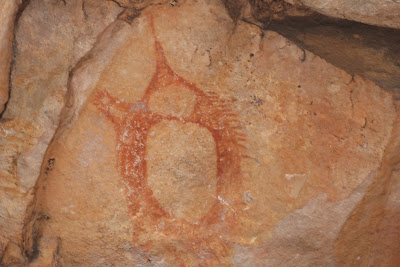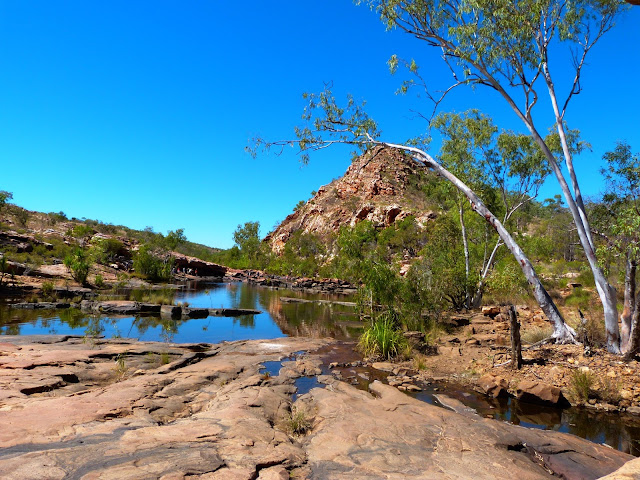After we left the colourful Windjana Gorge, we began a new phase of our journey - driving along the famous Outback highway, the Gibb River Road. This was an unmade road. Even though it had been graded since the last floods in the previous Wet Season, it was quite a bumpy ride!
Along that road, we first visited the remains of the old homestead on the cattle station where the young Jandamarra had lived with his mother for a while. I found that very moving.
If you saw the Opening Ceremony of the Commonwealth Games at the Gold Coast in Australia last week, you would have seen some performances by our Aboriginal and Torres Strait Islander people, including the Bangarra Dance Company. I have seen several performances of the Bangarra Dance Company. They are simply extraordinary and powerful, especially when telling the story of the early encounters between our First People and the white settlers with symbolic imagery and artistic and very talented dancing.
Many white people both here and overseas in those early times claimed Aboriginal people were ‘no better than animals’ - even sending their skulls to museums in England to try to prove they even had smaller brains (which of course was not the case)! The arrogant, ignorant beliefs of these white men were used to excuse and justify their brutality towards the Aboriginal people - the killing, the raping of the women, and the stealing of their land. On top of that, the early settlers introduced diseases that wiped out many groups of Aboriginals.
I am sorry to say that white people have gone on causing untold harm and heartache. Countless Aboriginal children were forcibly taken from their parents for years and years - ‘The Stolen Generations’. Different tribes were herded into settlements away from their sacred sites and land, and forbidden to celebrate their culture - their stories, their art, their dance, their music. If they tried, they were beaten. The consequence was most of their 500 or so different languages have disappeared and most of the Aboriginal people who were incinerated in this way lost so much of their spirit, their dignity, their way of life and incredible knowledge of medicines and bushcraft that had been passed down from one generation to the next over sixty thousand years. It is simply appalling! I am absolutely ashamed of all those who participated in this dreadful destruction of a people.
Now there are big social problems due to the introduction and promotion of alcohol into many Aboriginal communities by greedy white men. This has been just as destructive as tearing them away from all they knew. Before white men came our First People never drank alcoholic drinks, so they lacked the enzymes needed to break down the alcohol and were seriously affected when they drank. Between the way they have been treated and the introduction of alcohol, little wonder many have committed suicide and many have turned to drugs and alcohol and crime.
But that is only part of the story. Many Aboriginal people have risen above all this. We have had an Aboriginal State Governor, and many Aboriginal Members of Parliament, wise leaders, university lecturers, doctors, lawyers, authors, teachers, leading sportsmen and women, opera singers, musicians, artists, cattle station managers, and so on. And now various state governments are recognising that our indigenous people are far better at looking after our national parks than white people, so have given them charge of a number of parks. Thank goodness! They are far better custodians of our land than most white people.
But, in fairness, I also have to say that a lot of white people have worked tirelessly to redress the wrongs that have been perpetrated. I have tried to do my bit working alongside Aboriginal and white people to provide really worthwhile programs for school students. The students simply loved them! Through this I have met many wonderful Aboriginal people and learned so much of their story.
In the next post I will talk about the Wilderness Lodge where we spent that night and the next, and our visit to the spectacular Bell Gorge. In the meantime, enjoy the photos of the the old homestead, as well as some of the rugged scenery and majestic escarpments along the Gibb River Road. The photos speak for the selves, so I have not included captions this time, though I will say that since the signs were erected outside the old homestead, new evidence has shown that the Aboriginal people were here at least another 20 000 years earlier than the 40 000 years stated on the sign.This makes them the oldest living race in the world.


























































